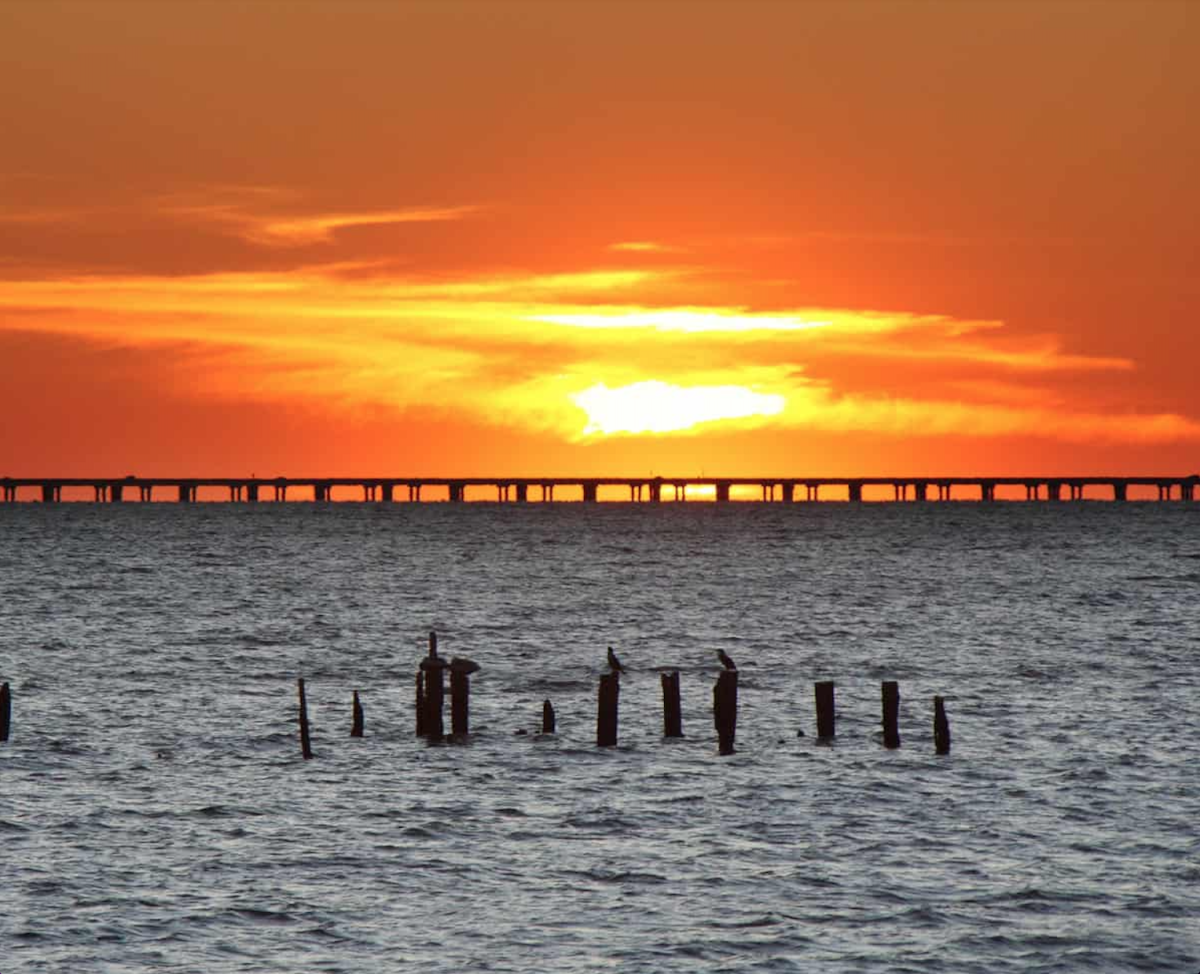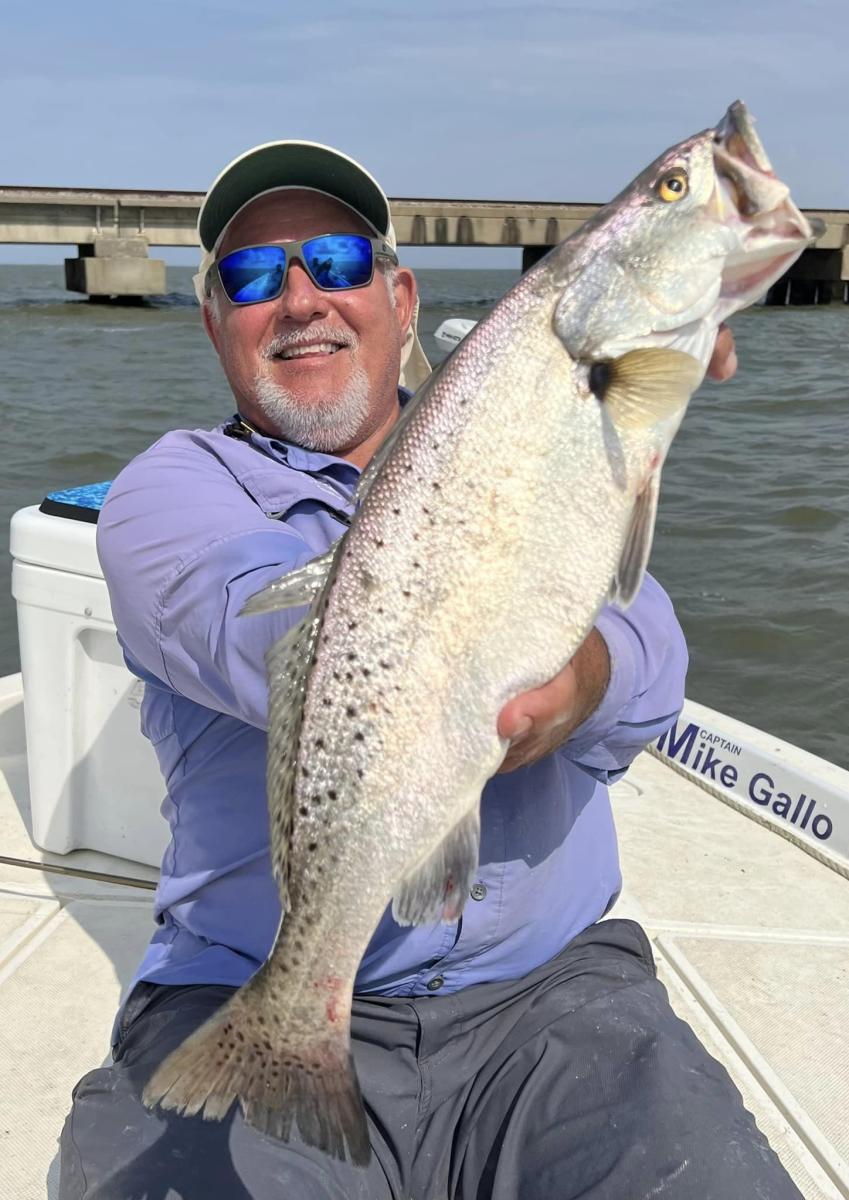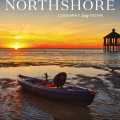For most anglers in Louisiana, trolling isn’t at the top of their list when it comes to their preferred style of fishing. The technique of dragging lures behind your boat until a fish bites may just be the last technique you want to engage in. But trolling the bridges during March and April has proven to be the best bet if you are looking for that trophy trout of a lifetime.

The sun sets on Lake Pontchartrain Causeway. This bridge has the potential to produce a state record trout on any given day.
Lake Pontchartrain Causeway
Spanning 24 miles, the Causeway is one of the top spots to fish in Louisiana. To understand why this bridge is such a magnet for speckled trout, it’s important to understand the underwater topography of the lake. Lake Pontchartrain’s bottom is made up of sand and silt and is flat with no structure. Because of this, the bridge’s concrete pylons attract smaller baitfish which feed on the microorganisms and crustaceans that cling to the bridge legs. The baitfish attracts trout and other predator fish looking for an easy meal in the lake.
Because the trout aren't concentrated in large schools in the spring, the best way to target them is trolling. Trolling, or "dragging baits" as it's sometimes referred to, is a method of casting out artificial lures and dragging them in the water behind the boat. The technique sounds simple but it’s a proven way to put big speckled trout in the boat! All that is needed is approximately 60-100 feet of line that is released behind the boat.
 Speckled: An angler battles this bridge trout after dragging a soft plastic paddle tail minnow along the Causeway.
Speckled: An angler battles this bridge trout after dragging a soft plastic paddle tail minnow along the Causeway.
As far as baits go, the most popular baits that anglers use are Rat-L-Traps. These lures are often followed by something called a trailer, which is a line trailing from the first hook to a soft plastic lure. The most popular lure to use as a trailer is a B-2 Squid. When trolling, it’s important to cover a lot of water and take note of what color baits the trout are biting on. Since the bite is finicky in the spring, lure color is very important. Typically, the water in the lake is clear during this time so natural colors like silver or gray work best.
Trout that are caught along the bridge by trolling baits typically range between 16” and 20” with trophy trout reaching upwards of 24”, which makes the Causeway a great spot to fish for springtime speckled trout.
Lake Pontchartrain Trestles
The Hwy 11 Train Bridge is another top choice for anglers who troll Lake Pontchartrain for trophy trout. The train bridge, which is often referred to as “The Trestles”, is one of three bridges that span the south shore to the north shore connecting New Orleans to Slidell. The bridge is located in the southern section of the lake and benefits from the salty water that the Rigolets produces, as it connects Lake Borgne to Lake Pontchartrain.
While anglers have three bridges to choose from, the Trestles continuously outproduces the Twin Span Bridge and the Hwy 11 Bridge. This is because of the history of the train bridge. The bridge was built in 1884 with creosote pilings. Since then, it has seen numerous upgrades, and along the way, debris left underneath the bridge has proven to be a bait magnet, attracting all sorts of predator fish like redfish, sheepshead, flounder, and best of all, trophy speckled trout.

Mike Gallo of Angling Adventures of Louisiana caught this speckled trout along the trestles.
Trolling the Trestles is similar to trolling along the Causeway. When dragging bait behind the boat, it’s important to pay attention to how far away from the pilings you are when the first fish strikes. Often these fish will be in the same area and a repeat bite will ensue after passing back through that location. As far as speed is concerned, during the spring a good speed to troll is around 2 mph. This speed is just fast enough to entice those big speckled trout to strike. How big, you may ask? The Trestles holds the distinguishing honor of producing the heaviest speckled trout ever caught in Louisiana waters: an 11.99-pound trophy caught by Kenny Kreeger in 1999. This bridge is truly a special fishing destination, and for those who take the time to troll the bridge, their efforts will be rewarded in the spring.
 Andy Jones of Wicked Fishing Charters caught this speckled trout trolling the trestles in the spring.
Andy Jones of Wicked Fishing Charters caught this speckled trout trolling the trestles in the spring.
Where to Launch?
Anglers who want to troll these bridges have four available boat launches that are within two miles of the bridge.
Mandeville Harbor - The public boat launch at Mandeville Harbor is located in the 100 block of Jackson Ave. in Mandeville. Three back-down concrete slips are available to launch boats. The launch is located east of the Causeway and is only a 5-minute boat ride away.
Madisonville Boat Launch - The Madisonville Boat Launch is located at 2001 Main St. in Madisonville, Louisiana. The launch contains two concrete back-down ramps. There is a fee included for those who access the launch. Passes are available for purchase to Route 22 Bait and Tackle located at 201 Hwy 22 West in Madisonville.
The Point Marina - The closest boat launch to access the Trestles is the Point Marina in Slidell. Located at 118 Harborview Ct. This boat launch offers anglers two concrete back-down ramps with a large parking lot. The launch is a paid launch and is located west of the Trestles. The Point marina is located east of the train bridge and is a 5-minute boat ride away.
Foggy Bottoms Boat Launch - Located in Slidell, this bayou empties into Lake Pontchartrain and allows easy access to the Trestles. It is located at 58047 Hwy 433 and is approximately a 15-minute boat ride to the train bridge.
Story and photos contributed by Keith Lusher, NorthshoreFishingReport.com.


